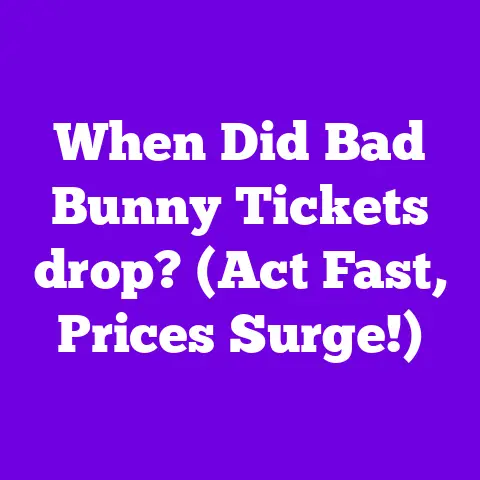When Are Ice Cream sales Highest? (Don’t Miss Peak Deals!)
If ice cream had a Ph.D.
in happiness, I’m pretty sure we’d all be enrolled in its sweet, creamy classes.
It’s a universal comfort, a celebratory treat, and a simple pleasure that transcends age and background.
But have you ever stopped to think about when we collectively scream for ice cream the loudest?
As we look ahead to 2025, understanding the dynamics of ice cream sales can unlock some pretty sweet deals.
Let’s dive in!
Section 1: The Ice Cream Economy
Ice Cream as an Industry
The ice cream industry is a colossal force, a multi-billion dollar market that continues to grow.
According to a report by Grand View Research, the global ice cream market size was valued at USD 79.04 billion in 2022 and is expected to expand at a compound annual growth rate (CAGR) of 4.5% from 2023 to 2030.
This growth is fueled by a combination of factors, including increasing disposable incomes, a growing appetite for indulgence, and the constant innovation in flavors and formats.
The landscape of the industry is diverse, ranging from established giants like Unilever (Ben & Jerry’s, Breyers) and Nestle (Häagen-Dazs) to the burgeoning artisanal brands that are popping up in cities across the globe.
These smaller, often locally-sourced brands are contributing significantly to the industry’s growth by offering unique flavors and experiences that appeal to a more discerning consumer.
Historical Sales Trends
Analyzing historical sales data reveals a clear pattern: ice cream consumption is highly seasonal.
The summer months consistently see the highest sales volumes, driven by warmer weather and a general increase in outdoor activities.
However, there are also fluctuations within the year, influenced by specific events and even the day of the week.
For example, data from the International Dairy Foods Association (IDFA) shows a significant spike in ice cream production during the months leading up to summer, as manufacturers ramp up to meet the expected demand.
Section 2: Seasonal Peaks and Trends
Summer Surge
The summer months, particularly June, July, and August, are the undisputed champions of ice cream sales.
This surge is driven by several factors:
- Temperature: As temperatures rise, so does our craving for cool, refreshing treats.
High temperatures directly correlate with increased ice cream consumption. - Cultural Events: Summer is filled with outdoor festivals, barbecues, and vacations, all of which provide ample opportunities to enjoy ice cream.
- Holidays: Memorial Day, Independence Day (July 4th), and Labor Day are all major holidays that fall within the summer months and are often celebrated with ice cream.
Special Occasions
Certain holidays and events act as significant drivers of ice cream sales.
Here are a few key examples:
- Memorial Day: The unofficial start of summer, Memorial Day weekend sees a surge in ice cream sales as people kick off their summer celebrations.
- Independence Day (July 4th): This patriotic holiday is a major ice cream consumption day, with families and friends gathering for barbecues and fireworks displays.
- National Ice Cream Day (Third Sunday in July): Celebrated nationally, this day is dedicated to all things ice cream.
Many ice cream shops offer special deals and promotions, further boosting sales. - Labor Day: The unofficial end of summer, Labor Day weekend is another popular time for ice cream consumption as people enjoy one last summer hurrah.
Marketing campaigns play a crucial role in amplifying sales during these periods.
For instance, many ice cream brands launch limited-edition flavors or offer special discounts around these holidays to capitalize on the increased demand.
Section 3: Regional Variations in Ice Cream Sales
Geographical Differences
Ice cream sales vary significantly by region, influenced by climate, demographics, and local preferences.
For example, warmer states like California, Florida, and Texas tend to have higher year-round ice cream consumption than colder states like Maine or Alaska.
Urban areas often see higher sales volumes due to greater population density and a wider variety of ice cream shops and parlors.
Rural areas, on the other hand, may have lower overall sales but can see spikes during local fairs and festivals.
Cultural Influences
Cultural influences also play a significant role in shaping ice cream flavors and sales patterns.
For instance, in some regions, unique flavors like green tea, ube (purple yam), or dulce de leche are particularly popular.
Local traditions and preferences can also influence sales.
In certain areas, ice cream is a staple dessert after meals, while in others, it’s more of an occasional treat.
These cultural nuances can significantly impact sales patterns.
Section 4: The Role of Marketing and Promotions
Advertising Strategies
Advertising and marketing strategies are essential for driving ice cream sales.
Social media campaigns, influencer partnerships, and traditional advertising methods all play a role in shaping consumer behavior.
Successful campaigns often focus on creating an emotional connection with consumers, highlighting the joy and nostalgia associated with ice cream.
Some brands also use targeted advertising to reach specific demographics or promote new flavors.
Peak Deals and Discounts
Sales promotions are a powerful tool for boosting ice cream sales, particularly during peak periods.
Common promotions include:
- Buy One Get One Free (BOGO) offers: These are highly effective at driving volume sales.
- Loyalty programs: Rewarding repeat customers with discounts and exclusive offers can encourage continued purchases.
- Seasonal discounts: Offering discounts on certain flavors or products during specific seasons can help clear inventory and attract new customers.
The timing of these promotions is crucial.
Launching them during peak sales periods, such as weekends or holidays, can maximize their impact.
Section 5: The Impact of Weather and Climate Change
Weather Patterns
Weather has a direct and immediate impact on ice cream sales.
Heatwaves, in particular, can lead to significant spikes in demand.
Conversely, unseasonably cool temperatures can dampen sales.
Data often shows a clear correlation between temperature spikes and ice cream sales figures.
For example, a study by market research firm Mintel found that ice cream sales increased by 15% during periods of extreme heat.
Climate Change Considerations
Climate change poses both challenges and opportunities for the ice cream industry.
Shifts in seasonal trends could alter traditional sales patterns, with warmer temperatures potentially extending the ice cream season.
However, climate change could also impact the availability and cost of key ingredients, such as dairy and sugar.
This could lead to price increases or changes in product formulations.
Section 6: The Future of Ice Cream Sales in 2025
Emerging Trends
As we look ahead to 2025, several emerging trends are poised to shape the future of ice cream sales:
- Plant-based ice creams: The demand for vegan and dairy-free alternatives is growing rapidly, driven by health concerns and ethical considerations.
- Health-conscious options: Low-sugar, low-fat, and protein-enriched ice creams are gaining popularity among health-conscious consumers.
- Innovative flavors: Unique and exotic flavors, often inspired by global cuisines, are attracting adventurous eaters.
These trends are likely to alter traditional sales peaks as consumers increasingly seek out these options throughout the year.
Consumer Behavior Insights
Changing consumer preferences are also influencing the ice cream market.
Consumers are increasingly interested in:
- Sustainability: Environmentally friendly packaging and ethical sourcing practices are becoming more important.
- Local sourcing: Supporting local businesses and farms is a growing trend.
- Experiential consumption: Consumers are seeking out unique and memorable ice cream experiences, such as customizable sundaes and interactive ice cream shops.
Conclusion: Summarizing Key Insights
In summary, ice cream sales are highest during the summer months, particularly from June to August, driven by warmer weather, holidays, and cultural events.
However, regional variations, marketing promotions, and emerging trends also play a significant role in shaping sales patterns.
As we approach 2025, it’s crucial to be aware of these dynamics to take advantage of peak deals and enjoy delightful savings.
Just like the joy ice cream brings, understanding its sales patterns can lead to delightful savings and experiences.
So, keep an eye out for those summer promotions and get ready to indulge in some sweet treats!






